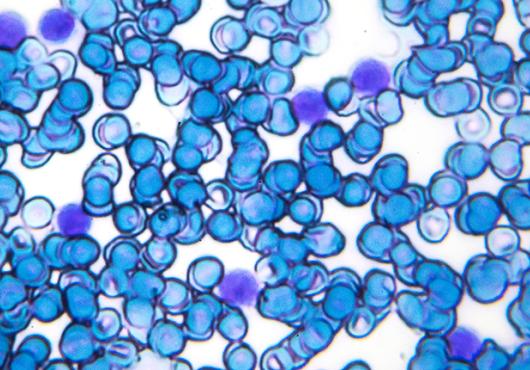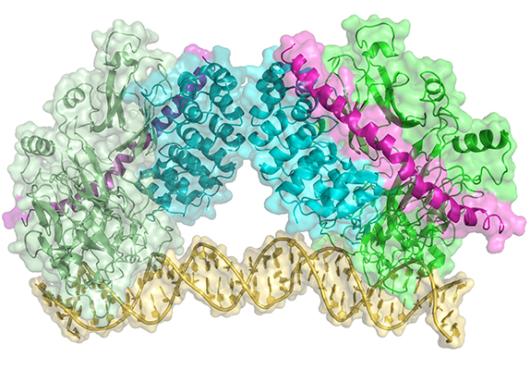
Acute myeloid leukemia, or AML, a blood cancer affecting adults and children, requires more than one genetic “hit” to develop.
As we age, many of us acquire a genetic mutation that enables certain blood cells to multiply faster than others, forming their own distinct population. This first hit, known as clonal hematopoiesis of indeterminate potential, or CHIP, isn’t necessarily harmful.
But if a second hit comes that makes those cells malignant, “it’s essentially a guarantee you will get leukemia in the not-too-distant future,” said Scott Armstrong, the David G. Nathan Professor of Pediatrics at Harvard Medical School and president of the Dana-Farber/Boston Children’s Cancer and Blood Disorders Center.
The result is a rapid buildup of immature, dysfunctional blood cells.
In research recently published in Science, Armstrong and colleagues propose that interfering with this second hit, specifically by using a compound currently in preclinical studies in mice, could stop AML before it gets started.
The work suggests that screening people for the first hit, then watching for and treating the second hit, could prevent AML from developing.
“The idea is that you would screen people and follow those who have clonal hematopoiesis and treat people who develop the second mutation,” said Armstrong, who is senior author of the study.
Early intervention
The researchers worked with mice that had the first hit, a mutation in the gene DNMT3A that is associated with CHIP.
When they introduced the second hit, a mutation in the gene NPM1, the mice went on to develop leukemia.
If these mice were treated early with a compound called VTP-50469, however, the premalignant blood cells stopped multiplying and leukemia never developed. There were no apparent toxic effects.
“We eradicated the cells that would ultimately become leukemia cells,” said Armstrong. “This is one of the first times we’ve had a molecule that’s effective and can act selectively on preleukemic cells rather than normal cells. We treated the mice for many weeks, and they’re just fine.”
It remains to be seen whether the findings can be replicated in people.
Learning from infant leukemias
VTP-50469 came out of earlier research by Armstrong and colleagues on rare, high-risk infant leukemias known as MLL-rearranged leukemias.
The compound targets a complex of proteins that join together and turn on the genes driving the leukemia. VTP-50469 disrupts two proteins in this complex, Menin and MLL. The complex falls apart, so the leukemia genes turn off.
In the infant leukemia study, done in mice and leukemia cell lines, VTP-50469 treatment led to sharp decreases in the number of leukemia cells, and, in some animals, remission of the cancer. Normal blood cells were unharmed.
“It turns out that more common adult leukemias are using these same mechanisms,” said Armstrong.
A close cousin of VTP-50469 is now in clinical trials in adults with relapsed AML. Armstrong hopes to see a similar trial launched in children with AML this year.
A model for preventive care?
While screening everyone over a certain age for clonal hematopoiesis may not be practical yet, one could imagine screening people who are thought to be at heightened risk for AML, such as those who had chemotherapy previously or in whom problems in the circulatory system are suspected.
The same preventive care concept could apply to other cancers that involve multiple hits, Armstrong believes.
“You need to know which mutations are important, and the order of the mutations, and you need to have a drug that’s relatively nontoxic, since you’re talking about a patient that, at that time, isn’t sick,” he said. “If you have a molecule that targets one of the early mutations, that’s really the holy grail: being able to intervene early in the cancer development process.”
Hannah Uckelmann, HMS research fellow in pediatrics at Dana-Farber/Boston Children’s Cancer and Blood Disorders Center, is first author of the paper.
The study was supported by the National Institutes of Health (CA176745, CA204639, CA066996, CA206963, P30CA008748 and U54OD020355-04), Wicked Good Cause, Cookies for Kids’ Cancer, SFB/the German Research Foundation (DFG, UC77/1-1) and Cancer Research UK (C22324/A23015).
Adapted from a post on Discoveries, the Boston Children’s research and clinical innovation blog.
Image: kieferpix/Getty Images




